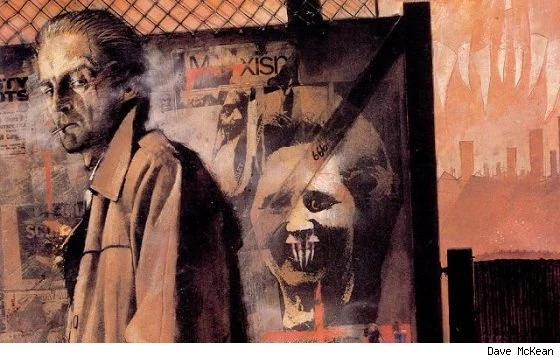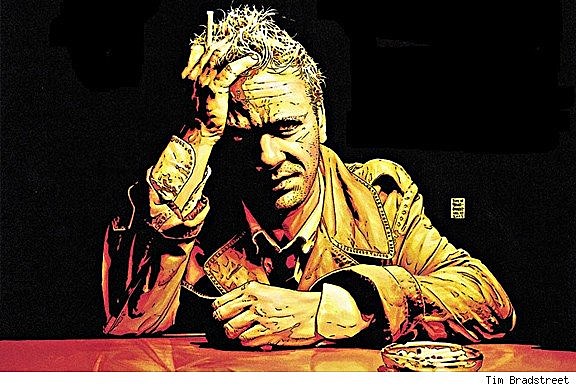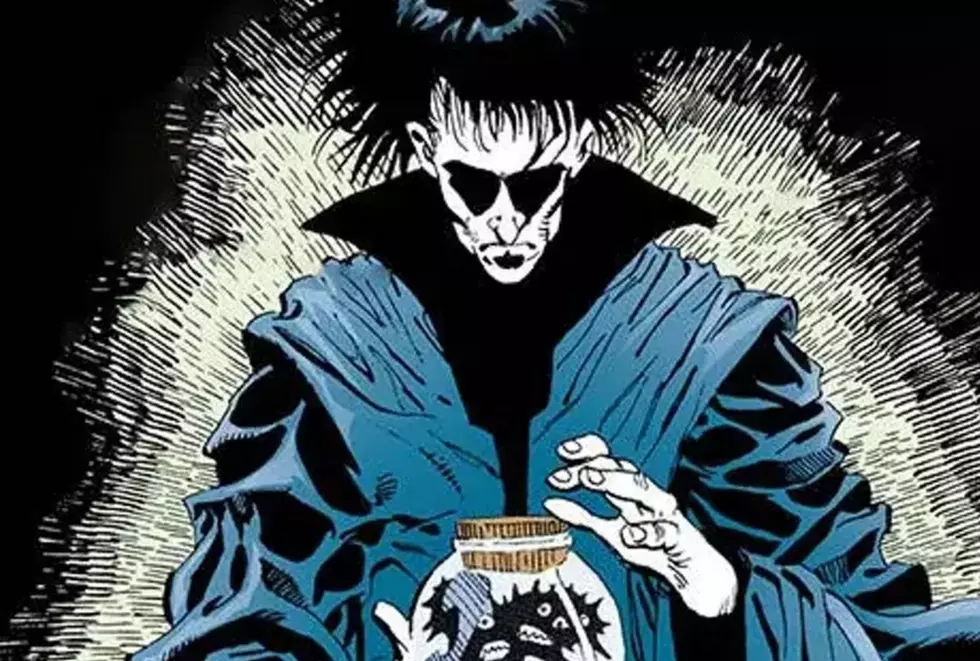
‘Hellblazer’ #300 Marks The End Of An Era For Constantine And Vertigo

With the 300th and final issue of Vertigo's Hellblazer, out this week, several tumblers shift and lock into place. John Constantine moves to the New 52 on a full-time basis, with a new title beginning in March; the reset button is pushed on his continuity, and the most writer-driven character of the last thirty years is yanked from the comfort and promise of a Mature Readers label and forced to grow up again in a PG-13 world; and the longest-running title in the Vertigo line concludes a twenty year run, as the imprint focuses exclusively on creator-owned comics. It's a sad time for misfits everywhere, as Hellblazer is one of a handful of comics from the late eighties that helped comic books and their readers grow up.The impact of the British Invasion can't be overemphasized. Alan Moore, Neil Gaiman, Grant Morrison, and others completely changed the way people thought about comics. They introduced readers to sharper prose styles, darker perspectives, and more sophisticated sensibilities, and defined the shape of mainstream American comics throughout the eighties, nineties, and well into the 2000s. You can't overemphasize an influence that's still being measured. But that effect may have not even been possible if those writers weren't allowed to work with the freedom of a Mature Readers label.

Like John Constantine, the trend began in Saga of the Swamp Thing. Less than a year after Alan Moore had taken over, the Comics Code Authority rejected issue #29, "Love and Death," on the basis of a two-page spread by artists Steve Bissette and John Totleben, and that the issue as a whole was a little too incest-y, entirely missing the point. Fortunately, their objection came too late for DC to do anything about it, and Karen Berger and the powers-that-be decided the issue was too good to scrap. Rather than redo it and resubmit for approval, they published it without the CCA's stamp, and lo and behold the world didn't end. So when Berger and crew got tired of the CCA's continued objections to what she and others felt was a high-quality series, DC just stopped submitting it. They decided that Saga of the Swamp Thing was special, and deserved its own special category: Suggested for Mature Readers.
It's into this world that John Constantine came to be - in the only mainstream comic that was created for adults. Artists Bissette and Totleben, at the peak of their powers, wanted to draw a character who looked like, of all people, Sting. (It's extremely important here to note that this was 1985 - Sting was still in The Police, artistically relevant, and decades away from picking up a lute, so the idea wasn't as ridiculous as it seems today.) They drew him for the first time in the background in Saga of the Swamp Thing #25. He's the one who looks like Sting. Actually, he's the one who practically looks into the camera and says "I look like Sting." The idea of a character with the likeness of Gordon Sumner latched on to an idea Moore had for a street-level magician, what he called a "blue-collar warlock," and John Constantine was born. During Moore's run, the character appeared in over a dozen issues, and had become popular enough to warrant his own series.

Hellblazer #1 appeared in late 1987, about a year before Morrison's Animal Man and Gaiman's Sandman. Over a beautiful cover by Dave McKean -- another British import -- the tag read "From the Macabre World of Swamp Thing 40 Pages of Sheer Terror." And up in the left corner, in the space where a CCA stamp would be, was the proclamation "Suggested for Mature Readers." And it's there that what would become the Vertigo imprint really begins to take shape -- two Mature Readers titles, entwined in shared history, effectively quarantined from DC's monthly continuity. They could interact with the DC universe proper, but they didn't have to; it wasn't mandate.
If you're forgetting how groundbreaking an idea that was, let me remind you: it was pretty groundbreaking. It helped that the comic itself was an instant classic, by two more Brits: artist John Ridgway, and one writer who often seems unfairly forgotten among the others in the Brit Wave, the supremely talented Jamie Delano. With a prose style that surpassed even Alan Moore -- you're goddamn right I said it, nearly all of his captions were jewels of odd beauty -- and a unique way of channeling his rage into horror stories, Delano debuted Hellblazer with a tone unlike anything else on the spinner racks.
Delano returned Constantine to his home in London -- in Swamp Thing, Moore took him all around the world, but never really explored his relationship with London, which seems almost laughable now -- haunted him with the literal ghosts of his failures, and pitted him against the real life terror of Thatcher's England. Bigotry, poverty, addiction, racism, greed, the AIDS epidemic, environmental collapse - social issues dressed in horror metaphors. The atrocities of modern life stitched up in devil costumes.

Over its first eighty issues, Hellblazer maintained a level of quality that few books could match, in voices that were impossible to duplicate. Delano wrote the first forty issues, save for a two-issue fill-in by Grant Morrison and a single issue by Neil Gaiman, which were excellent too. After Delano's run ended, Irish car-bomb Garth Ennis took over for another forty, starting with "Dangerous Habits," probably the most popular Hellblazer storyline, and generally regarded as the quintessential John Constantine story (though Delano's run remains my favorite). After Ennis, Paul Jenkins assumed the title for four years, and though he struggled initially, he eventually turned out some of the most memorable stories in the title's history. After Jenkins left, Warren Ellis was set to take the title for an extended run. However, shortly after his first story arc -- the amazing "Haunted" -- DC refused to publish an issue that dealt with high school shootings, due to the Columbine massacre, even though the issue was finished before the event and that would seem to be the perfect time to have something that dealt with the phenomenon. Ellis resigned, ending what could have been a very long, very special run. (The issue, "Shoot," was eventually published in Vertigo Resurrected #1 in 2010.)
Hellblazer was a writer's book. With all due respect to the artists who illustrated Hellblazer over the years -- and there were some very, very good ones -- it didn't really matter who was drawing it. Within its first few years, the book established a tradition unlike anything else. The quality of the character, uniqueness of the setting, and freedom of the Mature Readers labeling attracted great writers like a corpse gathering maggots. After some fill-ins by the first non-Brit, Darko Macan, the first American, Brian Azzarrello produced a fantastically violent run. After Azzarrello, Mike Carey. After Carey, Andy Diggle. After Diggle, and two fill-ins by Jason Aaron, Peter Milligan took over the title at issue #250 and wrote it up to its conclusion with issue #300.

It's so strange to write that Hellblazer is coming to an end. It seemed like it would always be there; maybe we took that for granted. Hellblazer never produced amazing numbers, but it was extremely popular among the Vertigo faithful -- it sold more than enough to get by. But those numbers have steadily waned. As great as Peter Milligan's run was -- and it was -- few years ago, the title was selling around twelve to thirteen thousand; recently it was around seven or eight thousand.
When DC reclaimed Swamp Thing and Animal Man for the New 52, the writing was on the wall. When they introduced a younger John Constantine, stripped of his Vertigo continuity, to the New 52 in Justice League Dark (at first, also written by Milligan), the writing turned to blood and started glowing. When Karen Berger resigned from her position as Executive Editor of Vertigo, it didn't matter anyway. Three years ago, I wrote that it wouldn't be a bad idea for DC to reclaim its Vertigo properties. I can see now how wrong I was.

The Vertigo of my generation is dead. Today's Vertigo is great too -- as of now solely publishing creator-owned material, the line is still a safe haven for anyone seeking great comics outside the norm. But for how long? It may only be a matter of time before DC does away with Vertigo completely -- when they take characters away and put the guiding light of the movement in a position where she feels forced to step down, things certainly aren't looking good. Hopefully, like John Constantine, Vertigo will keep finding ways to cheat death.
In a way he's done it again, leaving behind the changing landscape of Vertigo to land in the mainstream universe again, with Constantine debuting in March. With plotting by Jeff Lemire -- one of the greatest voices to emerge over the last few years -- scripts by Ray Fawkes, and art by Renato Guedes, Constantine returns the character to his roots in the superhero world, as he was in his very first appearances in Saga of the Swamp Thing. It also returns the character to stricter ratings, forces him to interact with the world of superheroes, and seems unlikely to deal with London's criminal underground, labor strikes, and poverty, demons that pose as financiers or take the form of addiction.
Hellblazer #300 is a powerful conclusion to an amazing story, and Peter Milligan, Giuseppe Camuncoli, and Stefano Landini send Vertigo's John Constantine off in proper fashion. It's a fitting, heartbreaking goodbye. As far as Constantine goes, my love for the character and respect for the creators involved means I'm going to give it an honest shot -- and you should too. But it already feels wrong. It's too colorful; it looks too much like a superhero book. He can't even say f**k anymore.
It's already not like Hellblazer. But then again, nothing ever was.

More From ComicsAlliance





![Jenny Sparks Enters The Scene In Ellis And Davis Hunt’s ‘The Wild Storm’ #3 [Preview]](http://townsquare.media/site/622/files/2017/03/TWS_Cv3_000.png?w=980&q=75)



